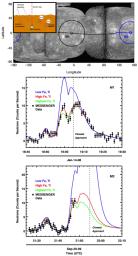
|
Mercury’s Surface Has More Iron + Titanium Than Previously Thought
- Click the image above for a larger view
- Full-Res JPEG (1036 x 1928) (221.8 kB)
- Full-Res TIFF (1036 x 1928) (6.0 MB)
Caption:
Mercury has a large, iron-rich core, which constitutes at least ~60% of the planet's mass. Observations from Earth and by MESSENGER at visible and near-infrared wavelengths have shown that Mercury's surface has a very low concentration of iron (Fe) in silicate minerals, leading to the common view that Mercury's surface and crust are generally low in iron. A puzzle for investigations of Mercury's formation and evolution is how a planet with such a large Fe-rich core could form with such an Fe-poor surface?
In the figure at the top, the areas on Mercury's surface measured with the MESSENGER Neutron Spectrometer (NS) during the first and third Mercury flybys (M1 and M3, respectively) are shown as circles. The spacecraft ground tracks for M1 and M3 are indicated by the black and blue lines, respectively. A mosaic of Mercury's surface in cylindrical projection is shown as background. The inset is a schematic illustration of how thermal neutrons are used to probe the iron (Fe) and titanium (Ti) content of Mercury's surface. Fe and Ti capture thermal neutrons very efficiently, so low fluxes of thermal neutrons indicate high abundances of these elements.
The middle graph shows the modeled and measured neutron counting rates for M1. The solid lines show predicted neutron counting rates for three different composition models: low Fe and Ti (blue), high Fe and Ti (red), and highest Fe and Ti (green). The low Fe and Ti model is similar in composition to the lunar highlands. The high and highest Fe and Ti models are similar in composition to lunar basalts from Mare Fecunditatis (Luna 16) and Mare Tranquillitatis (Apollo 11), respectively. A spacecraft maneuver was executed at 19:00 UTC that enabled the NS to measure an enhanced signal of thermal neutrons. The NS data (black circles) show that Mercury's surface fits the model with high Fe and Ti abundances, in contrast to previous ideas that Mercury's surface is low in Fe and Ti.
The bottom graph shows new modeled and measured neutron counts for just obtained during M3. While the data stop prior to 21:50 UTC because of the spacecraft safing event that shut off all data collection, enough NS data were returned to again show that Mercury's surface fits the model with high abundances of Fe and Ti.
These results from both M1 and M3 demonstrate that Mercury's surface has a significantly higher Fe+Ti content than was previously appreciated. Models for Mercury's formation and crustal evolution must be revised to take this finding into account.
Date Acquired:
January 14, 2008, and September 29, 2009
Instrument:
Neutron Spectrometer (NS) of the Gamma-Ray and Neutron Spectrometer (GRNS)
Background Info:
These images are from MESSENGER, a NASA Discovery mission to conduct the first orbital study of the innermost planet, Mercury. For information regarding the use of images, see the MESSENGER image use policy .
Cataloging Keywords:
| Name | Value | Additional Values |
|---|---|---|
| Target | Mercury | Titan |
| System | Saturn | |
| Target Type | Planet | Satellite |
| Mission | MESSENGER | 2001 Mars Odyssey |
| Instrument Host | MESSENGER | Mars Odyssey |
| Host Type | Orbiter | |
| Instrument | Gamma Ray Spectrometer (GRS) | |
| Detector | ||
| Extra Keywords | Color, Infrared, Thermal | |
| Acquisition Date | ||
| Release Date | 2009-11-03 | |
| Date in Caption | 2008-01-14 | 2009-09-29 |
| Image Credit | NASA/Johns Hopkins University Applied Physics Laboratory/Carnegie Institution of Washington | |
| Source | photojournal.jpl.nasa.gov/catalog/PIA12362 | |
| Identifier | PIA12362 | |
